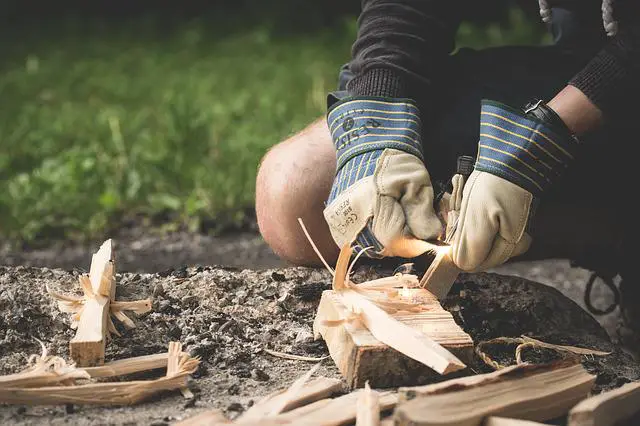How hot is a campfire, you ask? A typical campfire burns anywhere from 900 to 2000 degrees Fahrenheit, depending on several factors you can control when building your fire. Here are the main things affecting the temperature of a campfire.
More...
Table of Contents
Oxygen Flow
The first factor affecting the temperature of a campfire is how much oxygen it receives. Wind can make it difficult to light a fire. Once a fire is established, wind mainly feeds oxygen to the flames. This is why wind spreads wildfires instead of snuffing them.
Fires always burn hotter when they have more oxygen. This is the theory behind the Dakota fire hole, making a campfire significantly hotter by using thermodynamics to suck in cool air and rapidly feed the flame.
Slightly windy days produce the best campfire temperatures for most people. On still days, when the wind isn’t blowing, campfires won’t get as much fuel and won’t burn as hot.
Breezy days can feed a fire so fast that it jumps out of your pit and starts burning other things, making it dangerous to start a fire in those conditions.
Wood Species
Different types of wood burn at different temperatures, making this a significant factor in your final temperature.
For campfires, the best woods are those that will burn hot and even, which broadly means hardwoods.
Adequately-dried firewood is the best, but you can make do with fresher wood if necessary.
Most people measure the effectiveness of wood by how much heat energy they typically produce per cord.
A cord is about 128 cubic feet of wood. The name originated in 1610 when this was the volume wood was sold by, tied together with a cord.
The best hardwoods offer the equivalent of 200 or more gallons of fuel oil per cord of wood. These include options like American Beech, Sugar Maple, Yellow Birch, White Ash, and White Oak.
Mid-tier woods offer 150-200 gallons of fuel per cord. Black Cherry, Douglas Fir, White Birch, Red Maple, and Tamarack fall into this category.
The least-effective woods for campfires offer between 100 and 150 gallons of fuel per cord. Cottonwood, Red Alder, Red Cedar, Aspen, Hemlock, and White Pine are in this group.
Anything offering less than 100 gallons per cord isn’t worth using for a campfire.
What Are the Best Types of Wood
Each type of wood has different characteristics, but several stand out as particularly good for campfires.
Ash is widely available in most areas. It has little moisture, dries quickly, and doesn’t make too much smoke. It’s also lighter than many other kinds of wood, making it ideal if you need to carry your firewood a long way.
Cedar tends to make small but hot flames. This is ideal if you want to warm up a campsite or do some cooking. However, it’s not as good for activities like making s’mores, where a large fire is often helpful.
Hickory is a dense, low-moisture wood. It’s harder to cut than some other types, so it’s usually better to buy this ahead of time. However, it burns hot, and it’s excellent for grilling foods.
Oak is a good choice for most situations. It doesn’t burn quickly, but it does provide a lot of heat, so it’s ideal for maintaining a steady heat for a long time. It doesn’t create many sparks, so it’s relatively safe to use.
Is Soft Wood Acceptable
You can use softer woods like pine in an emergency, but it’s better to avoid them. Softwoods tend to have lower temperatures than hardwoods, and worse, they burn up much faster. That means you need more wood to keep a fire going.
Wood Sizes
The size of the wood you’re using has a significant effect on its temperature.
Once you get to the point of burning logs instead of tinder or kindling, a good piece of wood is about sixteen inches long and three to six inches wide.
If the wood is too large, it won’t burn through quite as well. If the pieces of wood are too small, they will burn up right away, making it harder to keep your fire steady.

Construction Style
How hot is a campfire if you build it correctly? Well, it’s probably going to be a lot hotter than a pile of wood randomly thrown together.
The most common shape is the teepee fire, also known as the cone fire. This simple structure has each log lean in towards the middle. It’s easy to build and maintain, with most of the heat concentrated in the central area above the center of the fire.
A log cabin fire has alternating rows of wood, perpendicular to each other. Log cabins tend to burn slowly, making them easy to maintain. However, they don’t concentrate the heat as much as teepee fires, so they usually don’t get quite as hot.
A platform fire is a denser version of the log cabin, with at least three logs in each layer instead of two. This is more solid than a log cabin and starts burning from the top, eventually working its way down. Platform fires tend to burn cooler and steadier because they have less oxygen flow than other styles, making them ideal for cooking.
A star fire is another long-lasting setup. In this format, you make a small teepee, then add more logs along the outside going directly away from the center of the fire. As they burn, you can push them in to maintain the flames.
Lean-to fires don’t burn quite as hot but use the firewood itself as a shield to protect the flames from the wind.
Checking the Temperature of Your Fire
How hot is a campfire burning? The easiest way to check the temperature of your campfire is by looking at the colors of the flames.
Blue is the hottest area you may find in a regular campfire. These are between 2600 and 3000 degrees and are usually the result of a campfire receiving enough oxygen to burn at the best rate. The Dakota fire pit method is particularly effective at creating blue flames.
White is the hottest most campfires can reach, around 2500 to 2900 degrees. A fire can flicker between white and blue if the conditions are right.
Yellow flames burn in the 2100 to 2500 range for most campfires. This is still hotter than amateur fires tend to reach, so you may not see any yellow flames.
Orange flames represent fire that’s 1800 to 2100 degrees. This is the upper end of what most campfires can reach unless advanced construction techniques are used.
Bright red flames are in the 1650 to 1800 range, while dull red flames are 1100 to 1650. This is what most flames in a campfire will probably be.
What About Green Flames
The colors of flames generally go from red to blue, so you might expect to see green just before you get to the hottest areas. However, physics prevents this.
Fires burning hot enough do emit green light, but they’re also emitting a lot of red and blue light at the same time. This means you only see the combination of them, which leans white.
To achieve green flames you have to burn in the middle of the range without getting the lower-temperature or higher-temperature colors. Most people who want green flames use chemicals to create them instead.

How To Make a Campfire Hotter
If you’re out in the wild, you may find that your campfire isn’t as hot as you’d like. Fortunately, there are a few things you can do.
First, try to scrape ashes out of the area. Ashes can interfere with burning and make it harder for a fire to reach its full potential.
Second, heat the metal if you can. Many fire pits and similar structures have metal along the outside. Spreading your fire out to heat that up will make the secondary burn hotter, and thus your overall fire as well.
Third, improve the airflow. Using a small electric fan to blow oxygen towards the fire (and smoke away) can provide more fuel and help you get a hotter flame.
Finally, use the best wood. Fresh, wet wood from the forest burns much worse than properly dried firewood. You can get firewood near most public camping areas, so pick up as much as you need instead of scavenging for wood on-site.
Don’t Forget Fire Safety
More than anything else, remember proper fire safety standards when you’re making a campfire.
- Are Merrell Shoes Good? – An Unbiased Review of Merrell Footwear - December 9, 2023
- Where Are Merrell Shoes Made? - December 9, 2023
- Camping in 40-degree Weather: Tips and Tricks - September 25, 2023

![Do Columbia Shoes Run Big or Small? [Here is the Answer] Do Columbia Shoes Run Big or Small? [Here is the Answer]](https://grandcircletrails.com/wp-content/uploads/2022/04/Do-Columbia-Shoes-Run-Big-or-Small-1-150x150.jpg)
![Do Columbia Jackets Shrink? [Here Is The Answer] Do Columbia Jackets Shrink? [Here Is The Answer]](https://grandcircletrails.com/wp-content/uploads/2022/05/Do-Columbia-Jackets-Shrink-150x150.jpg)
![How Old Do You Have To Be To Go Camping? [Answer Here] How Old Do You Have To Be To Go Camping? [Answer Here]](https://grandcircletrails.com/wp-content/uploads/2022/05/How-Old-Do-You-Have-To-Be-To-Go-Camping-150x150.jpg)


![How Long Will Ice Last in a Yeti Cooler? [Read Here] How Long Will Ice Last in a Yeti Cooler? [Read Here]](https://grandcircletrails.com/wp-content/uploads/2022/02/How-Long-Will-Ice-Last-in-a-Yeti-Cooler-1-150x150.jpg)